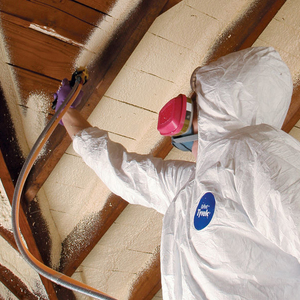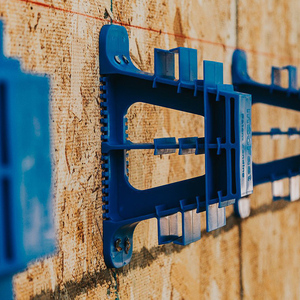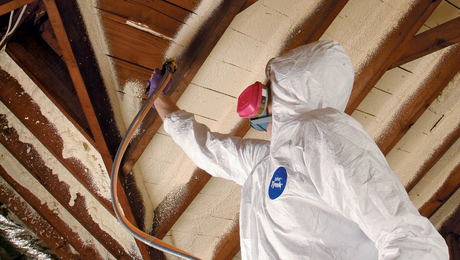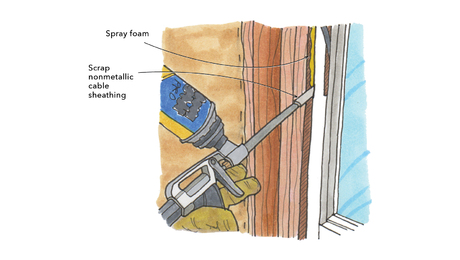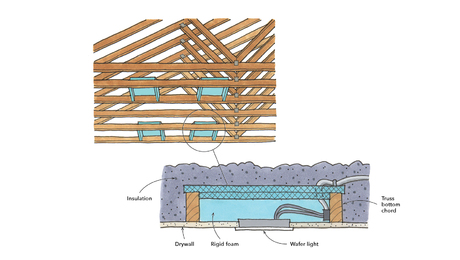Blown Insulation for Attics: Fiberglass vs. Cellulose
Both perform better than batts and are less expensive than spray polyurethane. Neither is perfect.

Synopsis: When you’re preparing to insulate an attic, the traditional choice of fiberglass batts might not be the best option. Blown insulation performs better than batts, and it is less expensive than spray polyurethane. GBA editor Martin Holladay compares and contrasts two types of blown insulation—fiberglass and cellulose. Loose-fill fiberglass has a low R-value (2 to 2.7) per inch, so it is best applied in attics that have enough room to accommodate insulation 16 in. to 26 in. deep. Blown-in cellulose is made of ground-up newspaper mixed with a borate-based fire retardant. Because it is denser than fiberglass, it is more effective at reducing air leakage. Cellulose has an R-value of about 3.2 per in. Cellulose can be problematic if it becomes wet. Because it can absorb a lot of water, leaks can cause severe water damage before homeowners become aware of them via damaged drywall.
Fiberglass-batt insulation is inexpensive but difficult to install well. Framing members aren’t always spaced perfectly, and it’s awkward to fit batts into irregularly shaped cavities and around electrical wires and boxes. Because few insulation installers have the patience required to install batts carefully, insulation performance suffers.
How much of an effect does sloppy installation have? According to energy expert Bruce Harley, a ceiling assembly with perfectly installed R-38 attic batts will have an R-value of about R-33, but if an installer leaves gaps amounting to only 5% of the insulated area, the R-value of the assembly drops to R-20.
When insulation fibers are blown into an attic, though, you get better performance. The material fills the nooks and crannies of framing bays, and fills gaps behind blocking, wiring, and other obstacles.
The two most common types of blown-in insulation are cellulose and fiberglass. Either product can be blown onto attic floors or dense-packed into wall or ceiling cavities. Because gaps are virtually eliminated, either product outperforms fiberglass batts. To install blown-in insulation, contractors or homeowners use a blowing machine. Small do-it-yourself machines can be rented or borrowed from many home centers; insulation contractors usually buy more-powerful commercial blowing machines. The blowers include a hopper where the fibers are poured, a motor, and a 2-in.- or 3-in.-dia. hose that delivers the insulation.
The R-value per inch of either type of insulation increases with density, so packing insulation tightly improves performance. High densities and thicker layers also help to lower air-infiltration rates.
Insulation costs vary widely from region to region. Cellulose usually costs more than fiberglass batts, and blown-in fiberglass usually costs more than cellulose. Both cellulose and blown-in fiberglass are considerably less expensive than spray polyurethane foam.
Builders concerned about convection and air leakage are more likely to choose cellulose, while builders worried about the ability of cellulose to hold moisture are more likely to choose blown-in fiberglass. As long as the R-value is appropriate and the insulation is installed correctly, however, either product will perform well.
Fiberglass
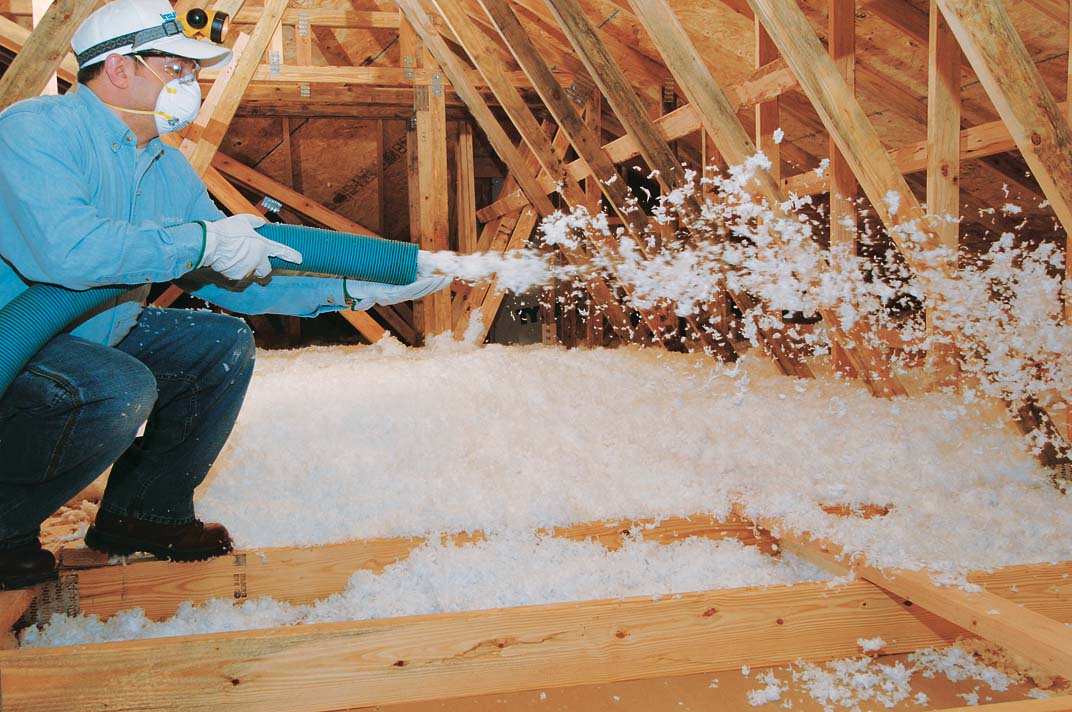
Blown-in fiberglass consists of milled glass fibers like those used to make fiber-glass batts. When it is blown onto an attic floor, it is referred to as loose-fill fiberglass. This material has a lower R-value per inch (2 to 2.7) than any other common insulation product, so it’s best applied in an attic that has enough room at the eaves to accommodate insulation installed 16 in. to 26 in. deep.
Convection is a worry only in the coldest climates
In 1991, researchers at Oak Ridge National Laboratory reported that when attic temperatures drop below about 0°F, convection currents passing through air-permeable loose-fill fiberglass cut the effectiveness of the insulation by 30%.
In response, fiberglass manufacturers pointed out that most U.S. attics are rarely cold enough for the problem to matter much. (While this may be true, the explanation provided little comfort to homeowners in northern Minnesota.) Energy experts advised concerned homeowners living in very cold climates to cap the loose-fill fiberglass in their attics with 2 in. of cellulose insulation; this effectively stops the problematic convection currents.
According to Johns Manville representative Mike Fay, the smaller fiberglass nodules in today’s loose-fill insulation significantly improve cold-weather performance compared to the products available to the Oak Ridge researchers in 1991. Fay says that R-value degradation in today’s loose-fill fiberglass insulation doesn’t occur until attic temperatures drop to –20°F. If that’s true, these changes minimize the convection problem in most locations outside Alaska and Canada.
Beware of fluffing
The reputation of blown-in fiberglass has been hurt by concerns about the deliberate “fluffing” of fiberglass by some unscrupulous insulation installers.
A series of investigative reports in the late 1990s indicated that most installers of loose-fill fiberglass were mixing too much air with the fibers during the blowing process, a practice called “fluffing.” (Unlike loose-fill fiberglass, cellulose insulation can’t be fluffed.) Whether done deliberately or accidentally, fluffing benefits insulation contractors by reducing the cost of their materials. Homeowners suffer, however, because fluffed insulation has a lower R-value than properly installed insulation.
Fluffing is specifically prohibited by the federal R-Value Rule. Insulation contractors are legally required to follow manufacturers’ label requirements dictating the amount of material that must be installed—the “bag count”—per square foot of attic. Wary builders or homeowners may wish to perform their own bag-count calculations—not a simple matter, unfortunately—and collect empty bags at the end of an insulation job.
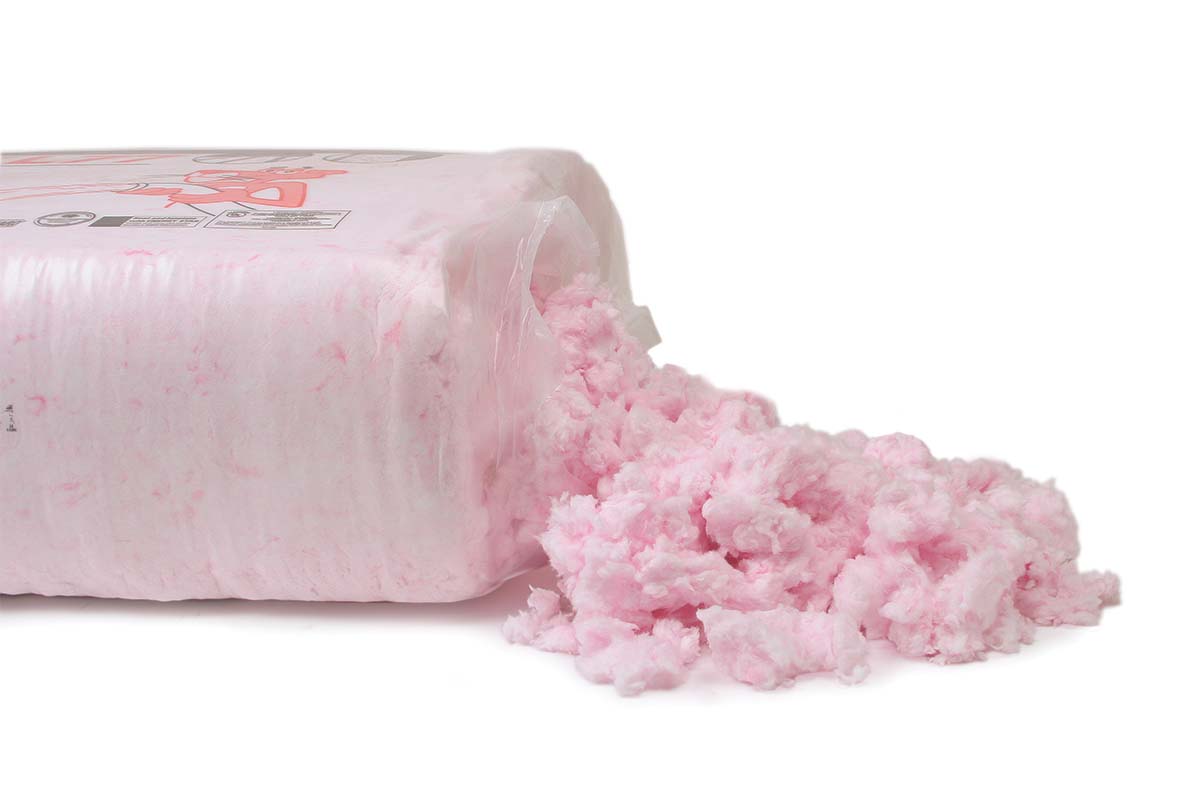
How many bags do you need?
To be sure you are installing the right amount of loose-fill fiberglass on your attic floor, follow these five steps.
- Measure the attic’s area.
- Visit the insulation manufacturer’s Web site to find a coverage chart showing the required insulation depth and minimum bag count for different attic R-values.
- Use the chart to determine the number of bags of insulation per 1000 sq. ft. for your particular R-value.
- Adjust this bag count to correspond with the attic’s area.
Verify that the depth of the installed insulation is equal to the depth shown on the chart.
For example, let’s say you want R-49 insulation installed in your 1500-sq.-ft. attic. Numbers vary by manufacturer, but according
to CertainTeed’s table, you need a minimum insulation thickness
of 181⁄2 in. and at least 25.2 bags of insulation per 1000 sq. ft. Adjust the bag count to your attic’s area: (25.2 x
1500) ÷ 1000 = 37.8 bags. If your contractor installs less than 181⁄2 in. of insulation or uses fewer than 38 bags, you’ve been cheated.
Cellulose
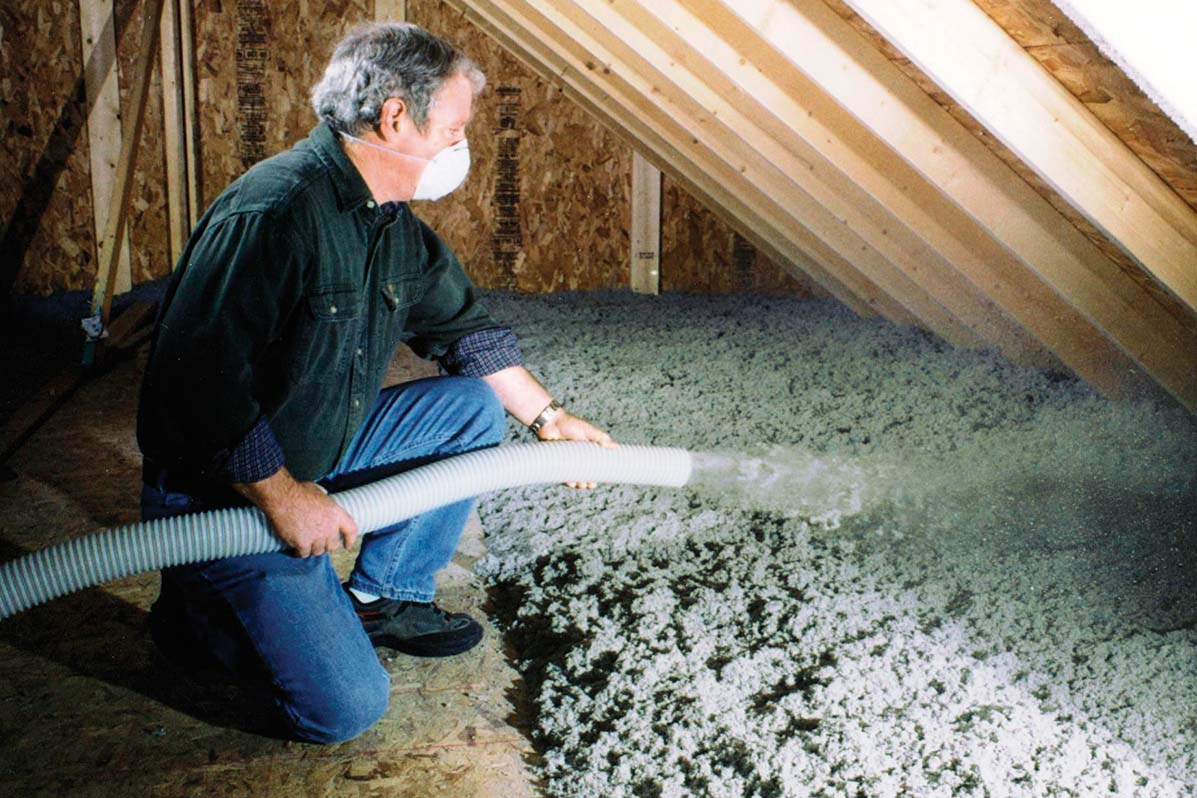
Cellulose insulation is made from old ground-up newspapers mixed with a borate-based fire retardant. It is an inexpensive material, has a high recycled content, has low embodied energy (that is, it requires little energy to manufacture), and is denser than fiberglass, which makes it more effective at reducing air leakage.
Denser means less airflow
Instead of using the old hammer-mill process, a method that left small pieces of newsprint intact, manufacturers are now milling cellulose fibers more thoroughly in a process called “fiberizing.” Milling the cellulose into smaller bits improves the insulation’s R-value per inch.
Because installed cellulose is not as air permeable as blown-in fiberglass, it is not subject to significant convection currents at cold temperatures.
Although dense-packed cellulose installed in a closed wall cavity can be as high as R-3.8 per in., the R-value of loose-fill cellulose for attics is about 3.2 per in. Settled cellulose insulation has a density of about 2.3 lb. per cu. ft. Higher densities are possible when cellulose is dense-packed into wall or ceiling cavities, and as density increases, so does the R-value per in.—up to a point. When compressed to beyond 4 lb. per cu. ft., the R-value per in. declines.
Plan for settling
Blown-in cellulose insulation settles over time. (Unless it is fluffed, blown-in fiberglass does not settle.) Everyday vibrations—for example, slamming doors—will, over the course of several months, cause attic cellulose to settle up to 20%.
The settling phenomenon is well understood by manufacturers, who print tables on cellulose bags showing the initial thickness at which attic insulation should be installed to achieve a given settled thickness. If the installer fails to account for settling, however, the R-value of the installed cellulose will be less than promised.

Water leaks can lead to trouble
If cellulose insulation gets wet due to a roof or plumbing leak, it will absorb a lot of water. Michael Chandler, a custom-home builder in Mebane, N.C., doesn’t like the fact that cellulose acts like a sponge. In two of his homes that developed plumbing leaks, “the moisture was absorbed and spread by the cellulose and took days to be noticed by the homeowner,” he recalls. Chandler is now more likely to use blown-in fiberglass than cellulose. “In my experience, cellulose holds onto moisture [from leaks] and allows it to accumulate in the building far more than foam or fiberglass.”
If the amount of wetting is minor—for example, if attic cellulose gets wet due to a one-time leak through a ridge vent—it will probably dry quickly without any adverse effects. In the case of catastrophic wetting, however, the ability of cellulose to absorb great quantities of water may delay the homeowner’s response because signs of water damage won’t appear until the water begins to soak into the drywall.
Photos courtesy of Johns Manville.
RELATED LINKS
- Unfinished-Attic Insulation Upgrade
- Two Ways to Insulate Attic Kneewalls
- Insulation for an Airtight House
Fine Homebuilding Recommended Products
Fine Homebuilding receives a commission for items purchased through links on this site, including Amazon Associates and other affiliate advertising programs.

Insulation Knife
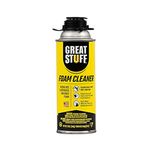
Great Stuff Foam Cleaner
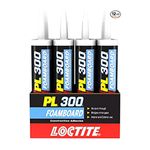
Loctite Foamboard Adhesive




